Canada and America are filled with many wonderful birds with yellow bellies – in fact, there are 34 birds that you can spot. Have you spotted a bird with yellow bellies that you’re looking to identify? Look no further than this article.
This article will list all 34 birds and help birdwatchers find and identify all birds of North America that have yellow bellies with both pictures and calls.
1. Yellow Warbler
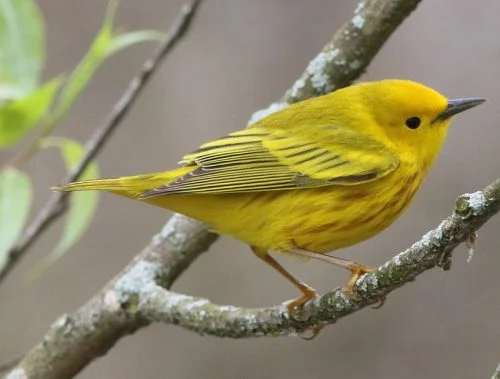
These golden group of warblers are given their name because their pigment is far brighter and much more prominent than the other yellow-bellied warblers on this list. They are uniformly yellow, with reddish flakes streaked across their sunny underparts, and their tails edged in yellow.
As well as being the most prominent in colour, these warblers have the widest range of all North American warblers.
These birds can be traced to the tops of small trees and dense shrubs, particularly in wetlands. Such trees include willows and cottonwoods, and any other similar vegetation. These birds can also be seen in yards and gardens, and sing whistled tunes from perches in peak breeding season. Such seasons sees them breeding in California, Georgia and Oklahoma, most likely foraging insects of all kinds.
To learn more about the Yellow Warbler you can visit: https://www.audubon.org/field-guide/bird/yellow-warbler
2. Common Yellowthroat
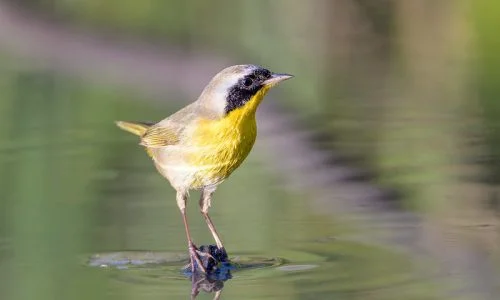
Common yellowthroats are small insectivorous songbirds. Adult males have a black face mask and are olive on top with a yellow underside. Adult females are solid olive brown with a yellow throat.
Young males may also show signs of the distinctive black face mask.
These birds primarily feed on insects such as wasps, grasshoppers, dragonflies, damselflies, moths, flies, ants, aphids, leafhoppers, mayflies, beetles, grubs, bees, cankerworms, and small spiders.
They are known to be protective of their nests and will approach them on foot rather than flying directly at them. Common yellowthroats can typically be found in North America during the spring and summer months, and migrate south from August to October to spend the winter in environments such as swamps, wet thickets, marshes, and margins.
To learn more about the Common Yellowthroat you can visit: https://www.audubon.org/field-guide/bird/common-yellowthroat
3. Wilson’s Warbler
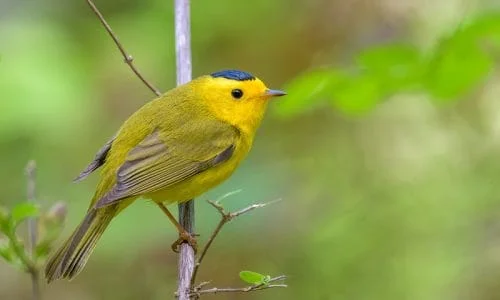
Wilson’s Warblers are notoriously colourful birds and are one of the smallest warblers found in North America. They mostly bare an olive-green on their upperparts, and a sunshine yellow colour on their underparts and faces.
Their heads are a striking black, with some black feathers also detailing along their backs too.
These birds can be seen year-round across much of the North American continent during breeding and migration, albeit more commonly in the West than in the East in states such as California.
In winter, they reside in southern U.S territories and further into Mexico. Breeding often occurs in mountain meadows and near streams, especially in close proximity to willow trees.
Shrubby habitats are great locations to spot these birds, as well as other wetlands. They feed primarily on insects, moving their tails in circular motions as they forage.
To learn more about Wilson’s Warbler you can visit: https://www.audubon.org/field-guide/bird/wilsons-warbler
4. Nashville Warbler
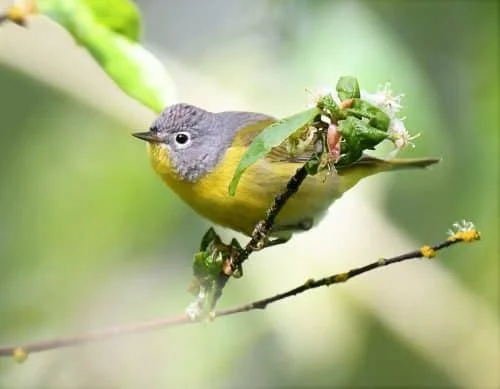
Nashville Warblers are no exception to the other stunning yellow-bellied warblers in this list. With golden underparts and a complimentary green back, there is no denying the allure of this petite songbird.
They are typically plump-bodied, with chestnut heads and two vibrantly white eye rings. An easy giveaway to help identify this breed is the intricate detailing of white and yellow from the belly to the undertail coverts.
Females are similar in pattern but expose a much paler colour. You can expect to find these birds among trees in states such as Montana, California and Idaho, sometimes further West towards areas such as Maryland.
They do, however, most commonly reside across much of Canada, as well as winter just south of the U.S. Mexican border. Usually they can be spotted foraging for insects among piles of leaves and twigs, often in congregation with other mixed flocks.
To learn more about the Nashville Warbler you can visit: https://www.audubon.org/field-guide/bird/nashville-warbler
5. Hooded Warbler
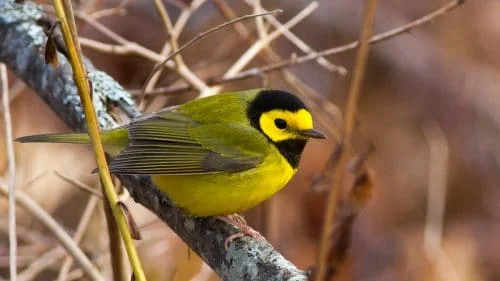
Compared to other warblers, Hooded Warblers have thick necks and are fairly heavy-bodied, despite being small birds. Adult males are pale green on their upperparts, and vibrant yellow bellies. Their name refers to a shape of a black hood that sits on their otherwise yellow face, although not all Hooded Warblers display this hood outline. They have blatantly black and round eyes and white spotted tail feathers, making them truly appealing birds.
These Warblers breed in much of the Eastern states, such as Wisconsin, Michigan and Southern New England.
They are often spotted to along Northern Florida. Their preferred habitats are mainly moist forests and dense wooded swamps and shrubs.
They are particularly reserved birds, typically staying hidden unless they are looking for insects along the brushes. In winter, they retreat southwards towards Mexico.
To learn more about the Hooded Warbler you can visit: https://www.audubon.org/field-guide/bird/hooded-warbler
6. American Goldfinch
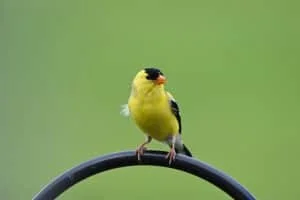
In peak breeding season, American Goldfinches bare vibrant, yellow bodies.
They are petite birds whose beaks are a distinctive cone shape and their heads are painted black. Along with their bright yellow underparts, these birds also have black and white wings and short, stocky tails. Females, however, are a duller and somewhat olive colour, and during the winter season both males and females have much browner plumages, with some minor displays of yellow.
These finches are noisy and active and spend most of their time throughout much of North America’s landscape.
The American Goldfinch is the official bird of Iowa, New Jersey and Washington State, where they are commonly spotted during the summer. These birds are also very attracted to Colorado, Oklahoma and the Carolinas, as well as southern parts of California and Utah. They also tend to winter in North America, so chances of spotting one is indeed very likely.
During the spring and summertime, these golden birds are commonly spotted flying over meadows in the sunshine, their yellow feathers are difficult to miss! They favour weedy fields, trees and brushes, often congregating in large flocks.
Often, too, these flocks are found at bird feeders year-round, albeit mostly in the wintertime.
They have also been spotted in other cultivated areas in the US, such as roadsides, yards and parks. These birds mainly eat seeds, particularly thistle and sunflower seeds, which are great at attracting them to feeders.
To learn more about the American Goldfinch you can visit: https://www.audubon.org/field-guide/bird/american-goldfinch
7. MacGillivray’s Warbler
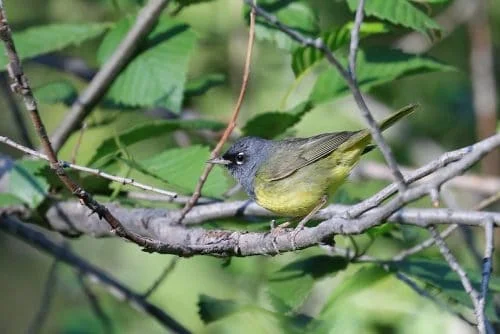
MacGillyvrays are particularly secretive songbirds, baring a soft yellow and grey pigment in their feathers. They have dusty grey hoods and speckles of white surrounding their deep black eyes. Unlike some other warblers, MacGillyvrays are somewhat lethargic creatures, most likely to be seen on the ground rather than up in trees and bushes.
They do, however, spend much of their time singing, with their loud morning song providing a blissful soundtrack to spring and summer mornings near open perches.
This species, however, is not particularly widespread in North America. Preferring to reside in Alaska and Mexico, these birds are also known to pay a visit to southern California and New Mexico during breeding season – and are a sight some people are truly lucky to see. In such locations, they can be found at forest edges, in growth along wooded streams and in other thick shrubberies.
When they aren’t singing, they spend much of their day foraging for insects on the ground.
To learn more about the MacGillivray’s Warbler you can visit: https://www.audubon.org/field-guide/bird/macgillivrays-warbler
8. Bananaquit
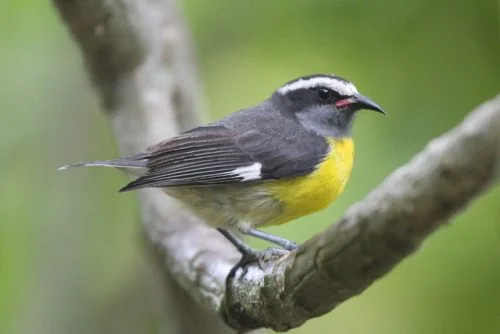
Bananaquits are very small, yellow-bellied birds with grey-black bodies and white throats. Their yellow undersides are uniquely bright, although females and infants bare a slightly paler pigment.
They are very fond of nectar, with sharp, curved beaks perfect for reaching it. The sharpness of the beak can pierce flowers sideways to retract nectar without pollinating the plant. Bananaquits are nicknamed ‘the sugar bird’ for their craving for granular sugar in bird feeders.
They are noisy songbirds, with high-pitched squeaks that can be heard year-round as they rummage for nectar.
Their fondness of nectar means that these birds are commonly spotted amidst flowering trees, bushes and gardens with many tropical and subtropical wildlife and flowers.
They are very much tropical birds, commonly found in the Caribbean, the Bahamas and Mexico. On rare occasions, vagrant Bananaquits can be spotted in Southern Florida, albeit mainly during winter.
To learn more about the Bananaquit you can visit: https://www.audubon.org/field-guide/bird/bananaquit
9. Bell’s Vireo
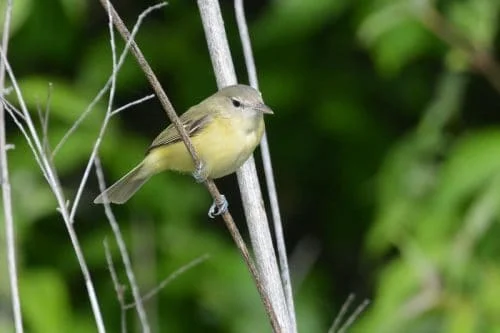
These are particularly small, secretive songbirds with slender builds and cocked, long tails. They have grey upperparts, as well as crisp white underparts, and yellow feathers across their sides and parts of their bellies.
Eastern Bell’s Vireos, however, have a deeper yellow wash on their underparts and their bodies are generally more olive toned. These birds are notably identifiable by the pale rings around their eyes, looking somewhat like spectacles.
They are very active creatures; whose songs help people find them whilst they hide amongst bushes and dense vegetation.
In recent years, these birds have been close to extinction due to widespread urban and agricultural developments tarnishing their habitation.
There has, however, been a great surge in the population of these birds in the last decade in places like Southern California, and the birds are now federally protected.
The species remains threatened in spite of this, as human developments advance.
Eager bird watchers may come across these birds in dense, brushy habitats across Southern California and Colorado, and southwards towards Indiana.
They tend to remain hidden in bushes to forage and often, they will reside in dense vegetation near streamlines and fresh water.
To learn more about the Bell’s Vireo you can visit: https://www.audubon.org/field-guide/bird/bells-vireo
10. Palm Warbler
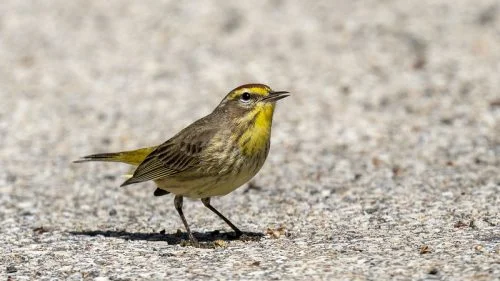
The palm warbler is a small, melodious bird known for its constant tail-bobbing and ground-foraging habits.
During the breeding season, the male’s cap turns a rosy color and both sexes can be identified by their yellow undertail covert, pale eyebrow, and dark eye line in the fall and winter.
These warblers primarily feed on insects such as beetles, flies, and caterpillars, as well as seeds and berries like bayberry, sea grape, and hawthorn. They tend to catch most of their insects from the ground or low plants, but also occasionally catch some in flight.
The palm warbler’s native habitat is the cold, boreal forest of North America, and they can be found breeding across the northern United States and Canada.
As neotropical migrants, they also spend the winter on the East Coast, ranging from southern Delaware to Florida, and from the Gulf Coast to southern Texas.
To learn more about the Palm Warbler you can visit: https://www.audubon.org/field-guide/bird/palm-warbler
11. Yellow-green Vireo
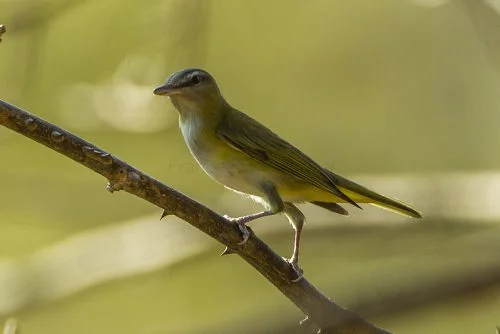
The yellow-green vireo is a small bird native to North America, belonging to the passerine family. It measures about 14-14.7 cm in length and weighs around 18.5 g. Adult vireos have a bright yellow underside, breast sides, and flanks, while their upper body is a yellow-green color.
Juvenile vireos have less vibrant coloring, with a brownish back and less yellow on their bellies, and brown eyes.
These birds primarily feed on insects found in tree leaves, particularly caterpillars and beetles, and also enjoy mistletoe berries. The breeding range of the yellow-green vireo extends from central Panama to southern Texas and across the western and eastern mountain ranges of northern Mexico.
In the winter, they migrate south to the western Amazon basin and the northern and eastern Andes, and can be found at altitudes ranging from sea level to 1500 meters in upper and middle levels of light woods, along forest borders, and in gardens.
learn more about the Yellow-green Vireo you can visit: https://www.audubon.org/field-guide/bird/yellow-green-vireo
12. Evening Grosbeak
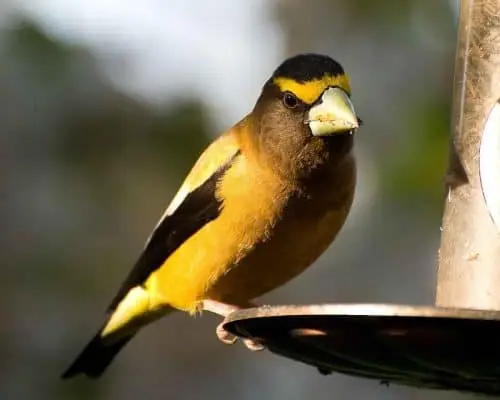
Evening Grosbeaks are exquisite finches, washed in bright yellow across their backs and underparts. They have deep brown heads and animated yellow eyebrows which extend to their foreheads. Females are somewhat greyer and paler and have a notable white tip on the tail.
These are stocky birds that are swift and particularly fast flyers.
These birds are typically found nesting in the mountains of California, and in dense woodlands and forests in areas such as New England.
In winter, they can be found in suburban areas along the Californian coast and towards Texas, retreating further south towards Mexico too. They feed on insects and seeds but also forage fruit and buds where available.
To learn more about the Evening Grosbeak you can visit: https://www.audubon.org/field-guide/bird/evening-grosbeak
13. Blackburnian Warbler
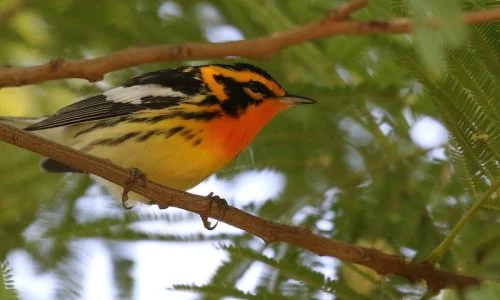
These Warblers are songbirds with an unmistakable yellow-orange pigment from their heads and down their throats to parts of their bellies. They have prominent black caps and cheeks, as well as white patches along the feathers of their wings.
Blackburnian Warblers are named after botanist Anna Blackburne; they are uniquely magnificent as no other warbler in North America bares such a brightly coloured throat.
They breed amidst the forests of North-eastern America, particularly in New England. In the winter they travel to South America and the Andes in pursuit of more tropical climates in open forests and coffee plantations.
In breeding seasons, they may be spotted among trees and dense brushes, as they often place nests at significant heights. Their song resembles a ‘buzzing’ noise, which may help you identify them in such locations.
They might also be attracted to backyards that have plenty of trees, and might be tempted by a bird bath or feeders providing mealworms. Their feeding preferences include insects that can be foraged from the branches of tall trees and forest lines.
Occasionally too they may catch insects whilst flying.
To learn more about the Blackburnian Warbler you can visit: https://www.audubon.org/field-guide/bird/blackburnian-warbler
14. Black-throated Green Warbler
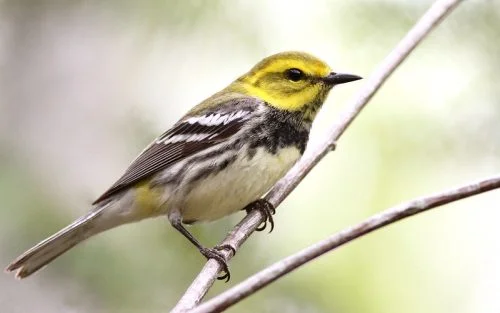
Black-throated Green Warblers are plump warblers of olive-green with bright yellow faces and underparts. They have notably large heads and chunky bills, with two starkly white wing bars. These birds are truly remarkable, be sure to notice their black eye stripes and dull, black throats.
They are agile songbirds and are extremely lively.
You might hear them sing tirelessly in breeding seasons, often perching out in the open and on tree branches to sing.
These warblers breed in Eastern Canada, and southwards to Minnesota, Ohio and New Jersey. They very much favour forests and treelines for nesting and to forage on small insects amongst the leaves.
In the winter, they retreat to Florida and Texas, as well as down into Central America, in pursuit of tall mature forests, often congregating in large flocks with resident birds.
To learn more about the Black-throated Green Warbler you can visit: https://www.audubon.org/field-guide/bird/black-throated-green-warbler
15. Blue-Winged Warbler
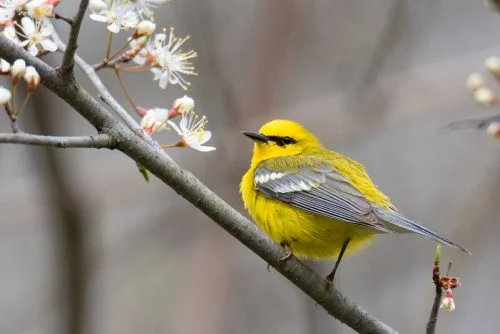
Blue-winged Warblers are remarkable yellow warblers that are petite and studry. They are washed in a golden yellow, with a sharp black line through their eye that appears pointed and paints them an angry expression.
Their name relates to their rich blue-grey wings which sit alongside their bright white wing bars, making these birds a spectacular sight to see.
They have prominent sharp bills, and the only main difference between males and females is their intensity of colour pigment.
Some may identify this bird by their two-note song that sounds very much like an insect or a buzzing noise. Adult males frequently sing such songs from perches in summertime.
These warblers are commonly spotted in overgrown habitats with tall trees, such as field edges and abandoned grounds.
Interestingly, they hang upside down from shrubs to forage on insects from leaf piles. In breeding season, these birds can be found in Minnesota, Iowa, Wisconsin and other regions near New England. They join other flocks of birds to migrate and tend to winter in the tropics of Central America.
To learn more about the Blue-Winged Warbler you can visit: https://www.audubon.org/field-guide/bird/blue-winged-warbler
16. Bullock’s Oriole
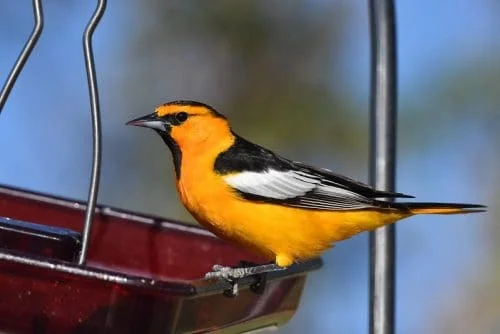
These Orioles are magnificent birds of flame-like yellow and orange with long wings and sharp blue-grey bills. They are mostly washed in bright orange, with black running from their crown to their back. Females are much yellower than the bright orange male, particularly on the breast.
Bullock’s Orioles breed most often in Western US states, particularly around California and Alberta.
They can also be found near the Dakotas and Texas during this time, too.
Most of this species retreat Southwards towards Mexico in the winter, however some remain residing along the coast of Southern California. They breed in brushy terrain, in habitats such as woodlands, parks and trees. They are especially fond of cottonwoods and can be found foraging around the outer branches of trees.
Orioles are particularly vocal birds, signing and whistling in trees and near rivers.
They commonly hang upside down from tree branches to forage for insects, and are notorious for their creation of remarkable hanging nests. In addition to insects, these birds also feed on fruits and berries, which can help attract them to your yard if you lay some out for them.
Bullock’s Orioles do not typically visit backyard seed feeders; however, these birds seek out nectar, and can raid hummingbird feeders for sugar water, as well as take nectar from garden flowers.
learn more about the Bullocks Oriole you can visit: https://www.audubon.org/field-guide/bird/bullocks-oriole
17. Canada Warbler

These colourful and energetic warblers are magnificent songbirds, sometimes called the “necklaced warbler” due to distinctive black markings along their bright yellow throats and breasts.
They are predominantly yellow and grey birds, and are rather small in size.
They are native to Canada, as their name suggests, frequently breeding across much of the Eastern land. They are also, however, residents of Northern Georgia during breeding season, and sometimes migrate over mid-to-Eastern states too.
These warblers spend very little time on their breeding grounds, however, often the first to arrive in the North in spring, and first to leave in Fall. They winter in South America, flying over 3,000 miles to their more preferred tropical climate.
Canada Warblers can be rather difficult to find, compared to other Warblers in North America. In fact, the population of this bird is declining rapidly in northern breeding areas. However, it is still possible to find these birds, they can be found most commonly in forest patches and moist woodlands with a lot of moss, ferns and shrubs.
To learn more about the Canada Warbler you can visit: https://www.audubon.org/field-guide/bird/canada-warbler
18. Cape May Warbler
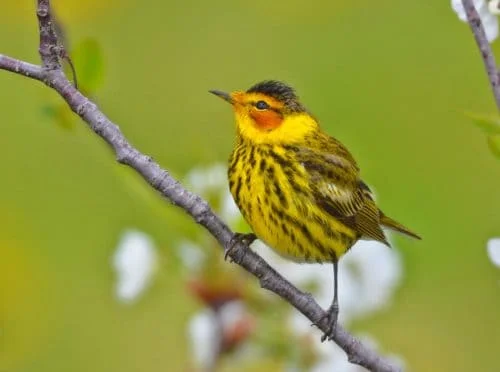
Cape May Warblers have very unique colour attributes that make them completely unlike any other warbler. Adult males have mossy green backs, bright yellow faces and tiger-striped breasts.
They also have chestnut brown patches dotted on their cheeks, and distinct black crowns. These birds have dark wings with stark white patches, although females are generally duller in colour. The remarkable complexity of pigment on these birds make them rather easy to identify.
The first sighting of this bird was recorded in Cape May, New Jersey in 1811, which is how this bird earns its name.
The species was not seen again there for over 100 years. These birds breed in Eastern states, namely North Dakota, Michigan, New York and Maine. They spend their winter in Florida, and further south towards Central America.
During breeding season, these birds reside primarily in open spruce forests, and they live remote from most human observers – making a sighting of one rather difficult. They spend most of their day foraging in high spruce trees for spruce budworms. Often, too, they will sip nectar from tropical flowers and hummingbird feeders in winter.
To learn more about the Cape May Warbler you can visit: https://www.audubon.org/field-guide/bird/cape-may-warbler
19. Western Meadowlark
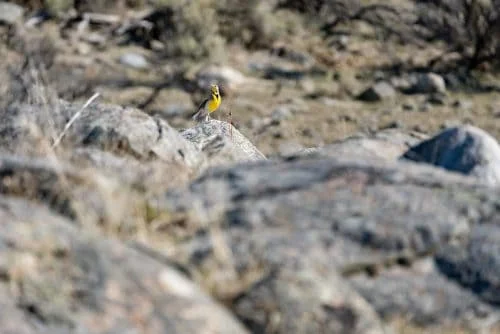
Western Meadowlarks are short and stocky yellow-bellied birds, identifiable in part by a prominent black “V” crossed on their bright yellow breast. They are streaked in brown and black on their upperparts, with a contrasting white stripe on their crown.
These birds are similar to the size of a robin, but they are heftier with a much shorter tail. In winter, however, these birds are far greyer in colour, which might make them difficult to identify.
These birds breed in much North American, particularly in Michigan, Ohio and Texas.
Their preferred habitats include open grasslands, meadows and prairies and can be seen singing from fence posts, power lines and bushes in summer. In winter, they are commonly be found in states such as Utah and Arkansas, often foraging on the ground in small flocks. They feed mostly on insects, but they may also feed on berries and seeds too.
To learn more about the Western Meadowlark you can visit: https://www.audubon.org/field-guide/bird/western-meadowlark
20. Orange-Crowned Warbler
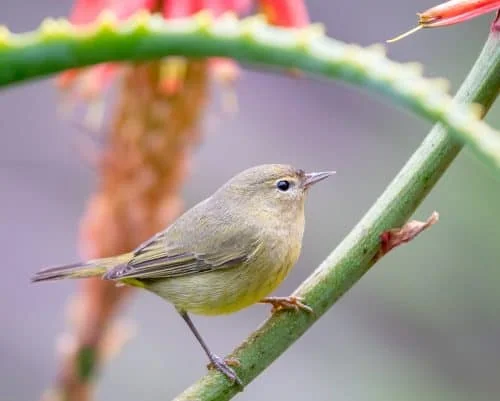
Orange-Crowned Warblers are mainly pale-yellow Warblers, sometimes baring a more olive-green pigment. They have streaked yellow underparts and distinct orange crowns that earns them their name.
These small songbirds are far thinner than other warblers, and have short, square tails. Be sure to pay attention to the intricate details on their eyes; they have a pale stripe along the eye, with a sharp black line through it and a faint ring around it.
During spring and summer, Orange-crowned Warblers can be found close to the pacific, in states such as California and New Mexico. They also breed further East into Southern Canada, where the species is far greyer in colour than the West coastal yellow birds.
Winter sees these birds retreat to Southern U.S into the tropics of Central America.
They nest close to the ground and forage among dense bushes and shrubbery and along treelines. They are very private and quiet birds, only singing occasionally to contact others whilst foraging.
To learn more about the Orange-Crowned Warbler you can visit: https://www.audubon.org/field-guide/bird/evening-grosbeak
21. Pacific Slope Flycatcher
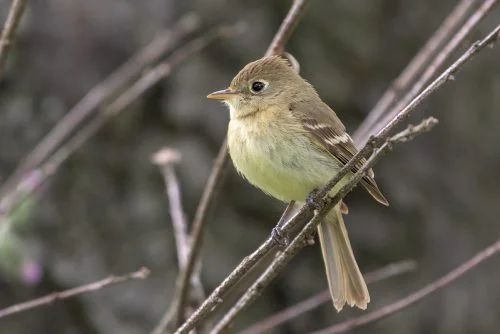
These are small flycatchers, mostly a lime colour with yellow bellies and throats. They bare a brighter yellow than other flycatchers alike and have bold white eye rings. An easy way to identify these flycatchers is through their sharp and high-pitched calls.
They are found mainly in woodlands and are native to coastal regions of the U.S, namely California and inland towards Alberta. In winter they typically stay close to the Pacific coast, sometimes flying southwards along coastal Mexico. They prefer forests, wetlands and other moist and concealed habitats along creeks and streams. Like other flycatchers, they feed on insects by catching them in flight, chiefly favouring mosquitos and caterpillars.
To learn more about the Pacific Slope Flycatcher you can visit: https://www.audubon.org/field-guide/bird/pacific-slope-flycatcher
22. Lesser Goldfinch
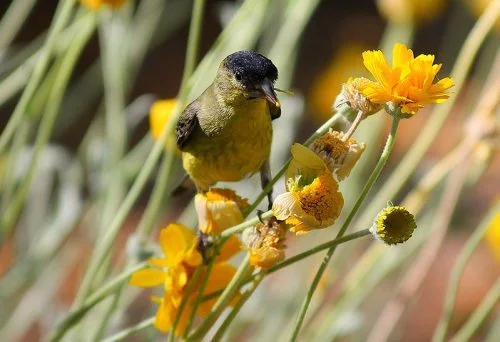
These finches are little, attractive songbirds with prominent yellow bellies and contrastingly dark upperparts. Their dark feathers are greener along the West coast, and a glossy black shade further East.
They have long, pointed black wings with stunning white markings.
Lesser Goldfinches are typically found in large flocks of up to a hundred at a time.
They are very much native to Southwestern U.S. in states such as Nevada, Texas, Oregon and Utah. Breeding occurs in a variety of habitats at various elevations. They prefer habitats such as woodlands and oak savannas but are also found in smaller flocks near thistle that grows near roadsides.
Bird feeders may also attract these birds as they feed on seeds and grains. Often too they would forage in weedy fields and bushes for insects.
To learn more about the Lesser Goldfinch you can visit: https://www.audubon.org/field-guide/bird/lesser-goldfinch
23. Western Tanager
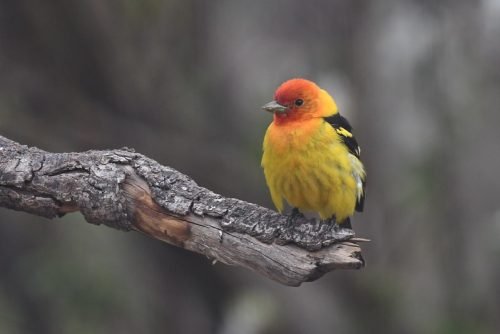
Western Tanagers are attractive songbirds that are stocky and heavy-bodied compared to warblers, although they are fairly small in size. They have extraordinary red heads and bright yellow plumages, with contrasting black backs, making them a terrific sight to see.
Their bright plumages are unmistakable, however when it comes to foraging, these birds can be very inconspicuous when required.
They feed primarily on insects and berries in mixed woodlands along North-western America. California, Texas and New Mexico are amongst some of the Western locations native to this species. In winter, they favour warmer climates found in Central America, although some remain within southern California.
To learn more about the Western Tanager you can visit: https://www.audubon.org/field-guide/bird/western-tanager
24. Dusky-capped Flycatcher
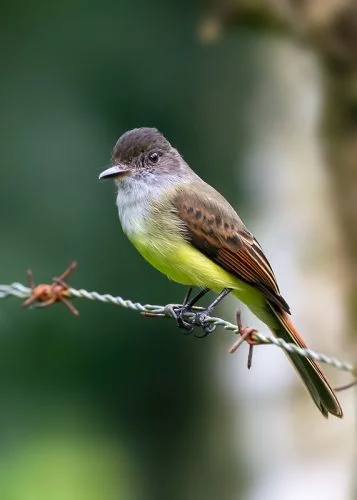
These yellow-bellied flycatchers are small and slender, with lengthy tails and long, hooked bills. They have olive-brown upperparts, with fair grey throats extending to a paler yellow belly. Their wings, however, are white with faintly reddened edges.
These birds are native to Mexico and are widespread in South America; they are somewhat limited in Northern American states. However, they can in fact be found in states such as Arizona, New Mexico and locally in Texas. They prefer habitats in oak woodlands and canyons, where they feed on insects and berries.
learn more about the Dusky-capped Flycatcher you can visit: https://www.audubon.org/field-guide/bird/dusky-capped-flycatcher
25. Kentucky Warbler
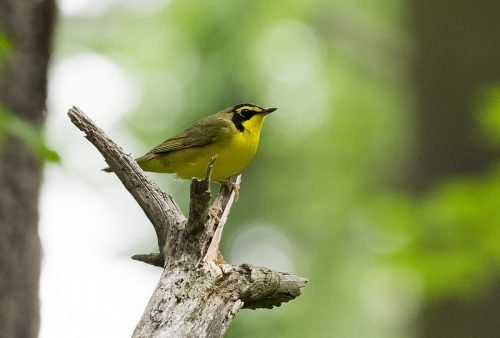
These warblers, like others, are tiny songbirds with stunning colour displays. Their yellow underparts are complimentary of the olive feathers on their backs, and they bare black ‘sideburns’ that extend down their faces to the ends of their throats. They have yellow markings around the eye and thick golden eyebrows, making for a rather unique picture.
Seeing one, however, may prove difficult as these birds are very secretive, often heard instead of seen.
They are only found in deep forests in lowlands, and close to streams and creeks.
The name Kentucky Warbler is given to these birds as the first sighting was recorded in this state. These birds can also be found breeding in Iowa, New Jersey and southwards towards Georgia, too. They forage on the ground for insects, particularly in vines and shrubs, and may also feed on fruit too in winter as they choose to reside in warmer climates in Central America.
To learn more about the Kentucky Warbler you can visit: https://www.audubon.org/field-guide/bird/kentucky-warbler
26. Connecticut Warbler
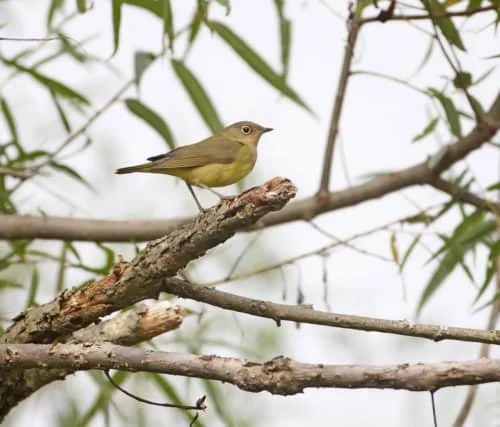
Despite being somewhat large birds that forage mainly on the ground, Connecticut Warblers are notoriously very difficult to find. They have fair yellow bellies and faint greenish-grey upperparts with a deeper slate-grey hood and white eye rings. Much like other, similar warblers, it earns its name from the state it was discovered and is occasionally referred to ‘Swamp Warbler’.
They forage on the ground through brushes, where the pale shade of their feathers conceals them in the moss and grass, making them difficult to spot. They do, however, sing from treetops near fresh water.
They forage among the leaves for insects and seeds. Connecticut Warblers breed in Minnesota, Wisconsin and Michigan, as well as in preferred alpine conditions in Canada.
To learn more about the Connecticut Warbler you can visit: https://www.audubon.org/field-guide/bird/connecticut-warbler
27. Worm Eating Warbler
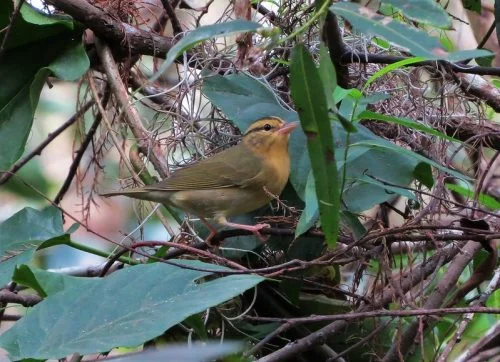
Like other warblers, Worm-eating Warblers bare an olive tone on their upperparts and have striking yellow bellies. They are somewhat paler than other warblers, however, displaying more grey tones amongst their many feathers. These birds have yellow heads and rich, black stripes along their crowns which might help the eager bird watcher to identify the species.
They almost exclusively eat worms, earning this species its name.
They typically forage in dead leaves, and sometimes eat caterpillars and moths too. North American states such as Iowa, Ohio and other southern states are home to these magnificent birds during breeding season.
They prefer dense woodlands and dry areas near hills and cliffsides, often singing loudly in a dry, insect-like voice. In the winter, they fly southwards towards more tropical climates, much like most other birds on this list.
learn more about the Worm Eating Warbler you can visit: https://www.audubon.org/field-guide/bird/worm-eating-warbler
28. Pine Warbler
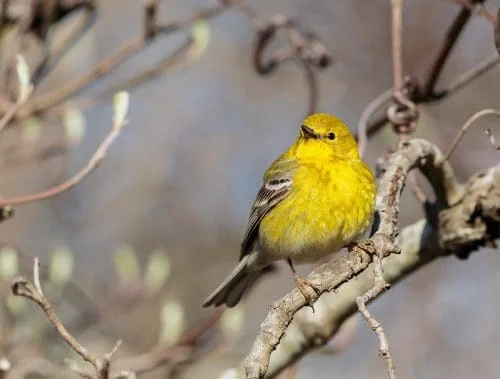
Pine Warblers are rather chunky birds, with exceptionally lengthy tails with a notch at the tip. They are prominent yellowish birds, with soft green feathers across their backs and yellow throats extending towards the belly that is streaked white.
These warblers have two bright wing bars and duller grey wings. Females can sometimes appear greyer and browner than males. The feathers of Pine Warblers display less patterns in comparisons with other coloured warblers, although their eyes are partly painted in a faint stripe.
These are the only warblers that eat an exceptionally large amount of seeds, they also feed on insects and fruit.
They can be difficult to spot, as they spend most of their time high up in pine trees. Although the do often forage on the ground and even visit seed feeders. Pine trees are likely the best option if you are looking to see these warblers, and they can often be heard singing rich trills from high grounds of pine forests or other mixed woodlands.
North Eastern states such as Maine are most commonly the home to these warblers, however they can be spotted in Texas and Florida during breeding season too. In winter, southern states are likely to attract this species.
To learn more about the Pine Warbler you can visit: https://www.audubon.org/field-guide/bird/pine-warbler
29. Cassin’s Kingbird
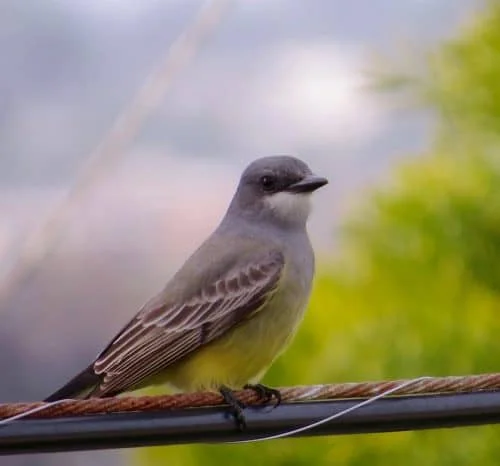
These birds are particularly large flycatchers of dark grey, with yellow bellies and prominent white marks above their beaks. They are far duller and darker birds in comparison with many other yellow-bellied birds of North America, but their noisy dawn song provides them plenty of attention.
These birds are native to Southern states such as California and Southern Montana, as well as further into Mexico.
Even in winter these birds stay rather loyal to such regions, with most sightings of them usually in southern California. If you walk along open woodlands, you may hear the infamous morning call of the Cassin’s Kingbird, particularly around dawn.
They perch on trees, branches and poles too which may be good locations to spot them. Often among shrubs and trees they can be found foraging insects and berries.
To learn more about the Cassin’s Kingbird you can visit: https://www.audubon.org/field-guide/bird/cassins-kingbird
30. Brown-crested Flycatcher
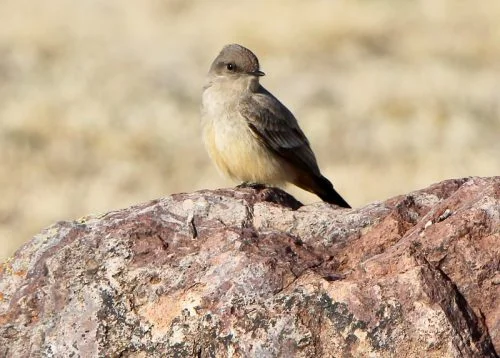
Another yellow-bellied flycatcher is the Brown-crested Flycatcher. These birds are grey overall, with flakes of red and brown across their tails and wings. Their bills are prominent on their faces, being long, heavy and a contrastingly rich black colour.
They tend to hover in flight, dipping here and there to forage between trees and shrubs.
This species is widespread across Central and South America; however, these birds also reside in some Northern states.
They breed in California, Nevada, Arizona and even Texas, preferring landscapes with trees and cacti – deserts occasionally being the favoured option. Their call notes are particularly helpful in identifying the birds, which are often various sharp trills.
In winter, they tend not to retreat much farther than their desired Northern states, but can also be found in Louisiana and Florida during this season.
To learn more about the Brown-crested Flycatcher you can visit: https://www.audubon.org/field-guide/bird/brown-crested-flycatcher
31. Prairie Warbler
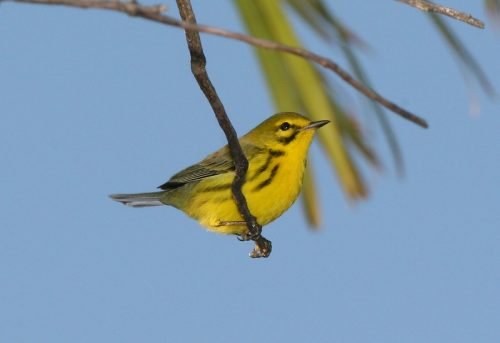
These warblers, like many others on this list, are small songbirds with conspicuous yellow throats and bellies.
Their upperparts are olive-toned with dark red streaks through the feathers. Prairie Warblers are outstandingly bright, with vibrant yellow heads and eyes. These birds have black streaks on their sides, making for a distinguishing pattern that is easily identifiable.
Prairie Warblers are very much creatures of North-eastern America, breeding mainly in the New England area and occasionally found south towards Florida, where they spend much of the winter season.
They are found in mangroves and overgrown fields and, despite their given name, they are not in fact found in prairies all that often. Amongst such vegetation they forage for insects, often wagging their tails up and down.
To learn more about the Prairie Warbler you can visit: https://www.audubon.org/field-guide/bird/prairie-warbler
32. Mourning Warbler
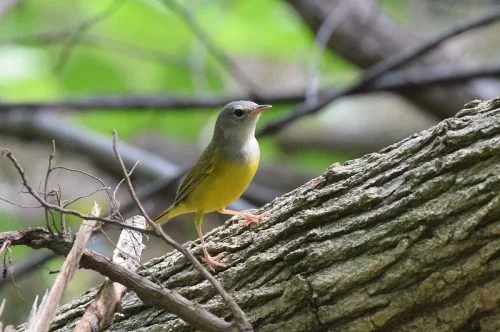
These are small but mighty songbirds, with thicker necks and bodies than many other warblers. They are named because their dark breast and grey hood resemble someone mourning. Their underparts, however, are a contrasting sunshine yellow, along with their olive-green backs. Female and infant Mourning Warblers have much more muted colours and less white details on the feathers than the traditional male.
This breed favour high elevations. In areas such as New England and the mountains around Virginia, these birds can be found breeding and nesting in forests. They forage low to the ground in brushes and thickets of berries, and are frequently spotted hopping along the ground for insects.
If not detected by their loud song, these birds typically stay hidden among the overgrowth within woodlands. Wintering birds remain hidden, often retreating towards the tropics of Central America.
To learn more about the Mourning warbler you can visit: https://www.audubon.org/field-guide/bird/mourning-warbler
32. Yellow-breasted Chat
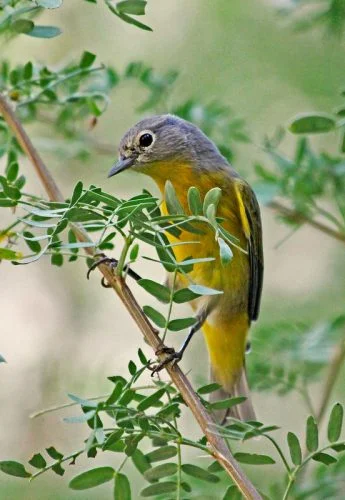
Here we have the largest of all North American warblers, despite actually being still considered as a small songbird. Chats are beautiful creatures, their feathers intertwining green and yellow colours that make their dark eye patches stand out.
They also have distinct sage wings and tails and grey faces.
Expect to find these birds among dense, rich areas of wild growth – such as brambles and shrubs near wetlands.
They tend to lurk among such low, thick vegetation, staying well hidden from humans (unless heard when singing from a perch). Much of this species reside in warmer, coastal states such as California and Florida.
Their preference of warmer climates also means they are very much creatures of the Caribbean, and more Central regions of the Americas.
To learn more about the Yellow-breasted Chat you can visit: https://www.audubon.org/field-guide/bird/yellow-breasted-chat
33. Scott’s Oriole
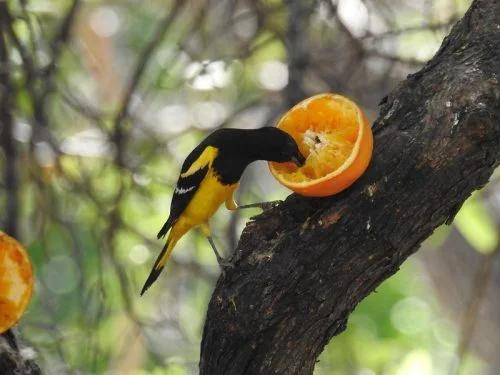
These birds are found primarily in Southwestern U.S. states. In such areas it is difficult to find birds that are as vibrant and colourful as this species. Their bellies are bright yellow, with complimentary yellow shoulder patches and golden tails.
The rest of their bodies are washed in a dark black shade, and their rich, contrasting colour palettes stand out against the dry, desert landscapes they are most commonly found flying over. Scott’s Orioles are renowned singers and can be heard before dawn and throughout much of the day. They are relatively easy to spot and make for an incredible sighting.
These Orioles are restless creatures and are found inhabiting high mountains, canyons and desert landscapes, particularly near palm trees. In palms these birds typically prefer to nest, as well as pinyon-junipers and pines.
Often, they are found in small, mixed flocks, foraging for insects and nectar. States such as California, Nevada, Utah, Arizona and Texas are among the best places to catch a glimpse of this species.
To learn more about the Scott’s Oriole you can visit: https://www.audubon.org/field-guide/bird/scotts-oriole
34. Kirtland Warbler
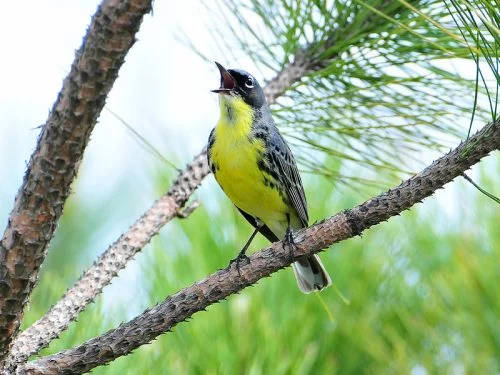
These are among the rarest warblers and, much like other warblers, are an attractive lemon colour with black detailing on their upperparts and face (this black pigment sometimes appears blue).
They notoriously nest on the ground, and only breeds among Jack Pine forests – mainly in Michigan and occasionally in Wisconsin. In winter, however, they can be spotted in the Bahamas.
To learn more about the Kirtland Warbler you can visit: https://www.audubon.org/field-guide/bird/kirtlands-warbler
